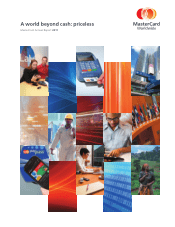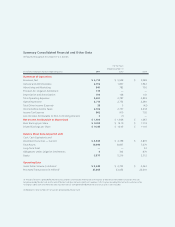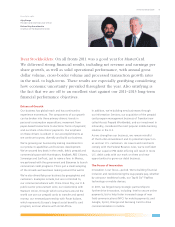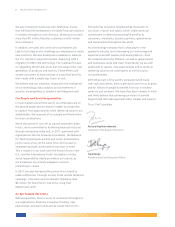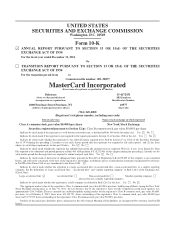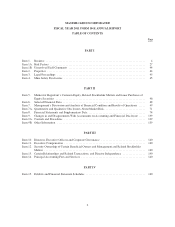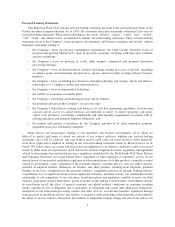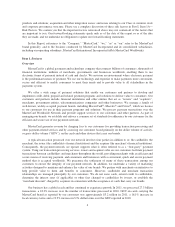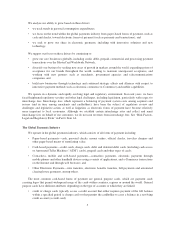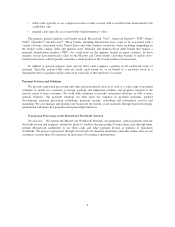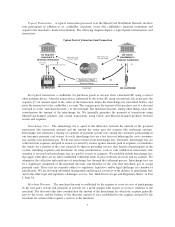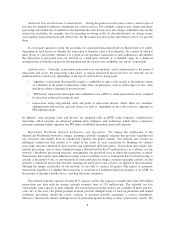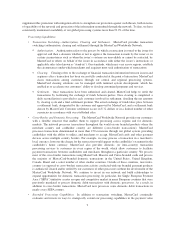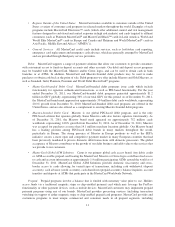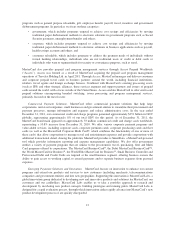MasterCard 2011 Annual Report Download - page 9
Download and view the complete annual report
Please find page 9 of the 2011 MasterCard annual report below. You can navigate through the pages in the report by either clicking on the pages listed below, or by using the keyword search tool below to find specific information within the annual report.We analyze our ability to grow based on three drivers:
• we track trends in personal consumption expenditures;
• we focus on the trend within the global payments industry from paper-based forms of payment, such as
cash and checks, toward electronic forms of payment (such as payment card transactions); and
• we seek to grow our share in electronic payments, including with innovative solutions and new
technology.
We support our focus on these drivers by continuing to:
• grow our core businesses globally, including credit, debit, prepaid, commercial and processing payment
transactions over the MasterCard Worldwide Network,
• diversify our business by seeking new areas of growth in markets around the world, expanding points of
acceptance for our brands throughout the world, seeking to maintain unsurpassed acceptance, and
working with new partners such as merchants, government agencies and telecommunications
companies, and
• build new businesses through technology and continued strategic efforts and alliances with respect to
innovative payment methods such as electronic commerce (e-Commerce) and mobile capabilities.
We operate in a dynamic and rapidly evolving legal and regulatory environment. In recent years, we have
faced heightened regulatory scrutiny and other legal challenges, including legislation, particularly with respect to
interchange fees. Interchange fees, which represent a balancing of payment system costs among acquirers and
issuers (and in turn, among merchants and cardholders), have been the subject of regulatory review and
challenges and legislative action, as well as litigation, as electronic forms of payment have become relatively
more important to local economies. Although we establish certain interchange rates and collect and remit
interchange fees on behalf of our customers, we do not earn revenues from interchange fees. See “Risk Factors-
Legal and Regulatory Risks” in Part I, Item 1A.
The Global Payments Industry
We operate in the global payments industry, which consists of all forms of payment including:
• Paper-based payments—cash, personal checks, money orders, official checks, travelers cheques and
other paper-based means of transferring value;
• Card-based payments—credit cards, charge cards, debit and deferred debit cards (including cash access
or Automated Teller Machine (“ATM”) cards), prepaid cards and other types of cards;
• Contactless, mobile and web-based payments—contactless payments, electronic payments through
mobile phones and other handheld devices using a variety of applications, and e-Commerce transactions
on the Internet and through web browsers; and
• Other Electronic Payments—wire transfers, electronic benefits transfers, bill payments and automated
clearing house payments, among others.
The most common card-based forms of payment are general purpose cards, which are payment cards
carrying logos that permit widespread usage of the cards within countries, regions or around the world. General
purpose cards have different attributes depending on the type of accounts to which they are linked:
• credit or charge cards typically access a credit account that either requires payment of the full balance
within a specified period (a charge card) or that permits the cardholder to carry a balance in a revolving
credit account (a credit card);
5

